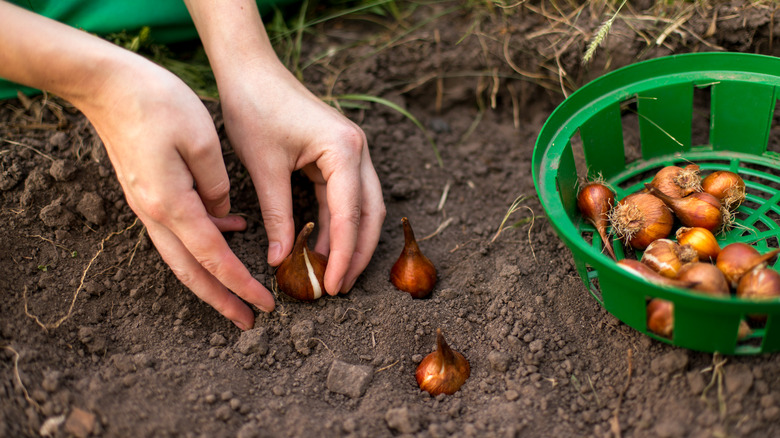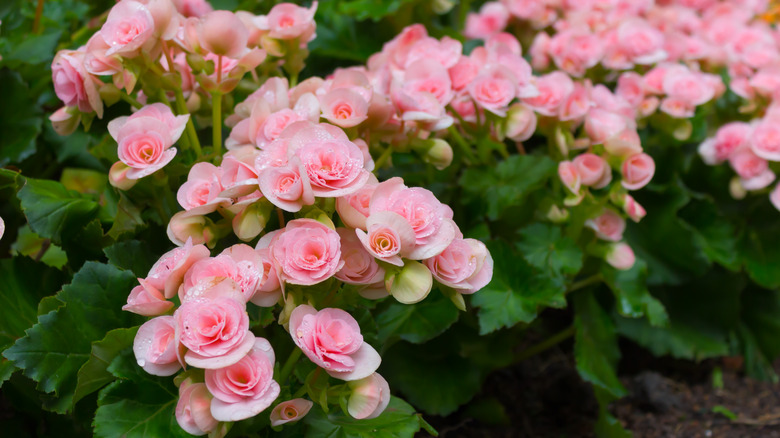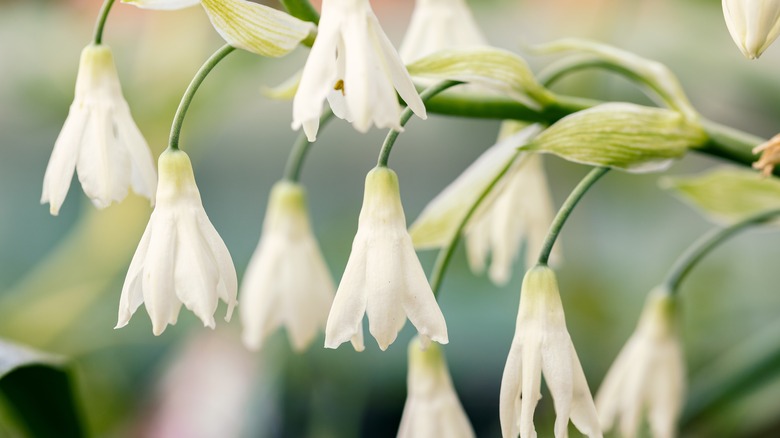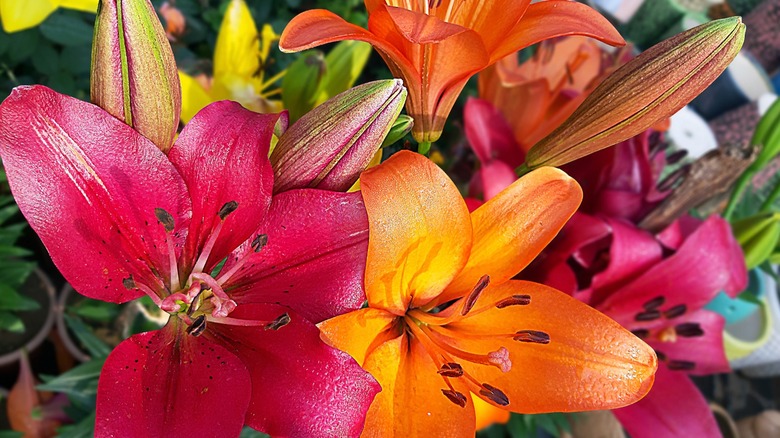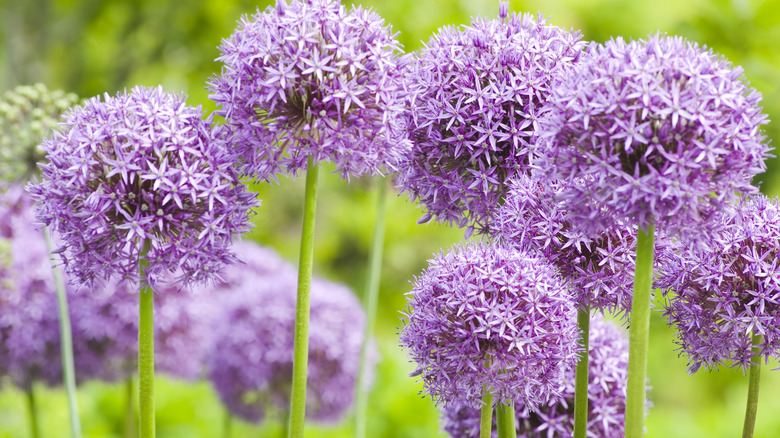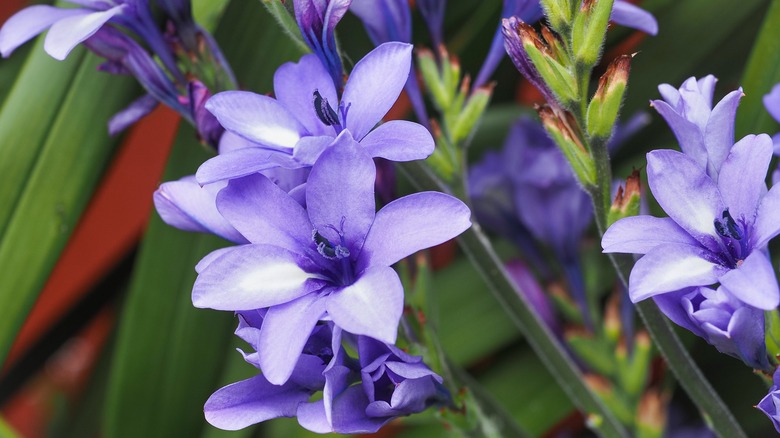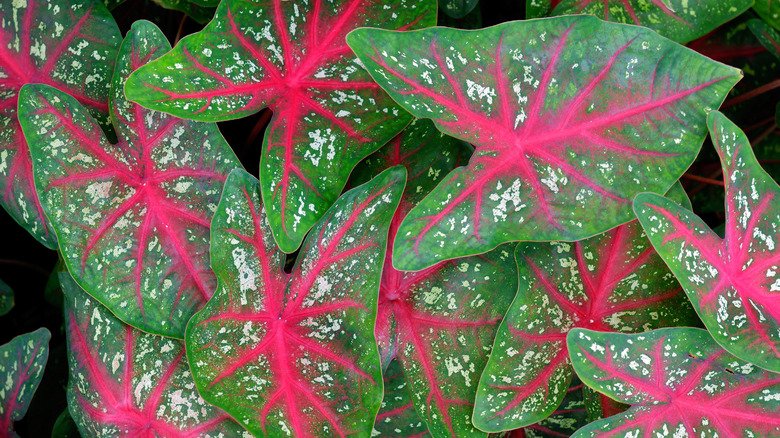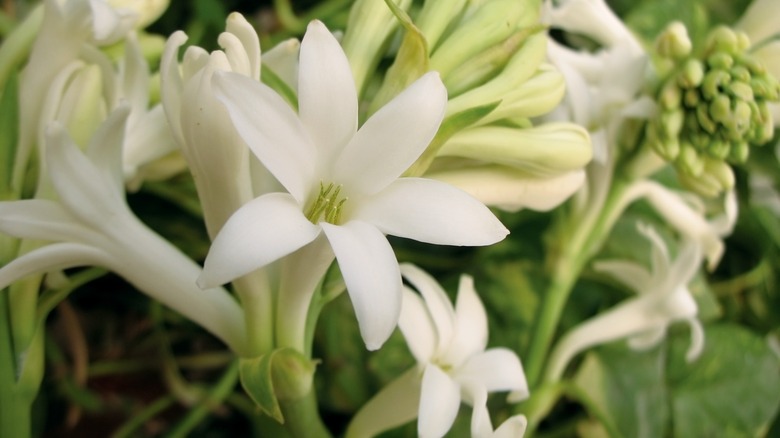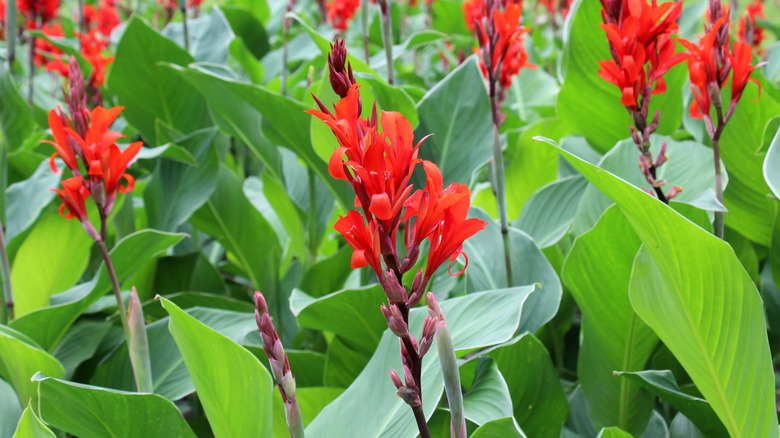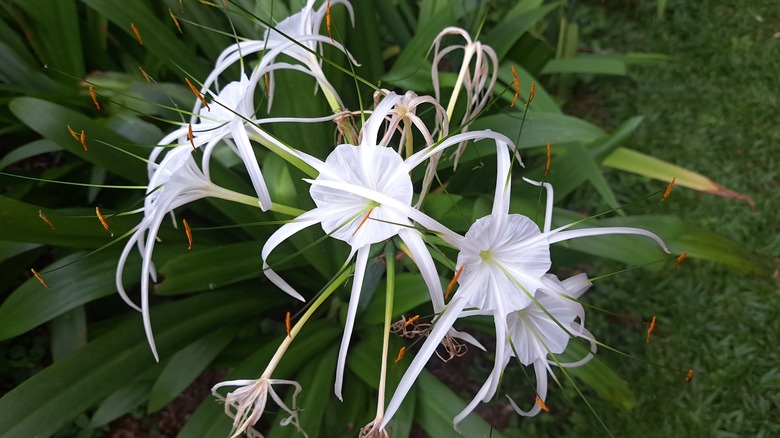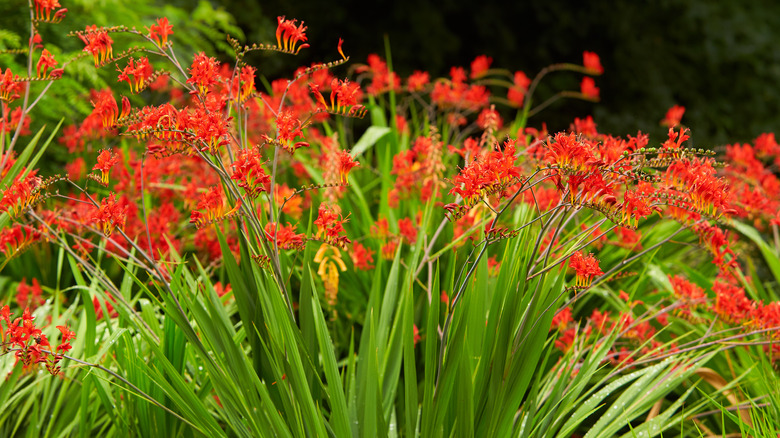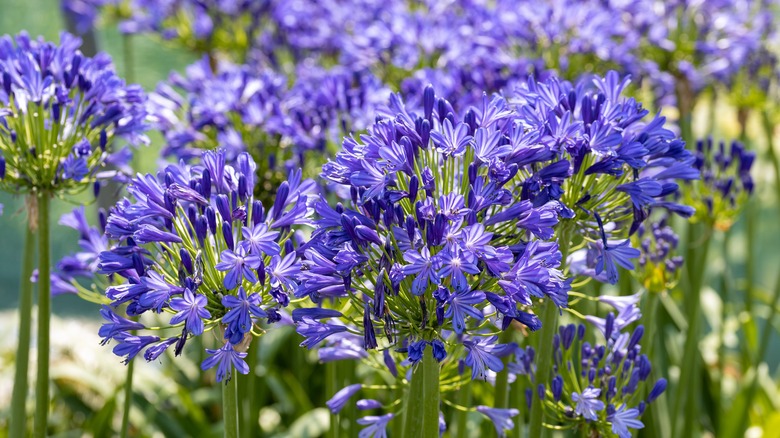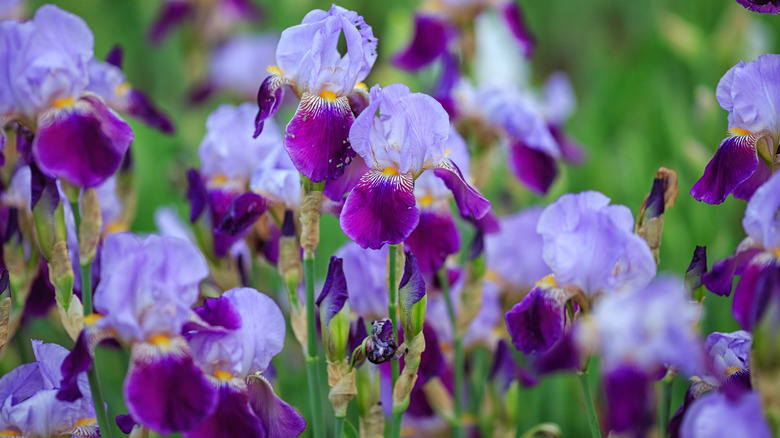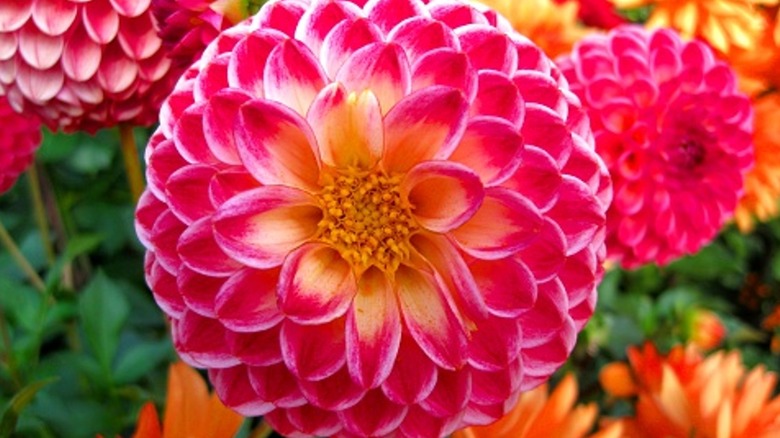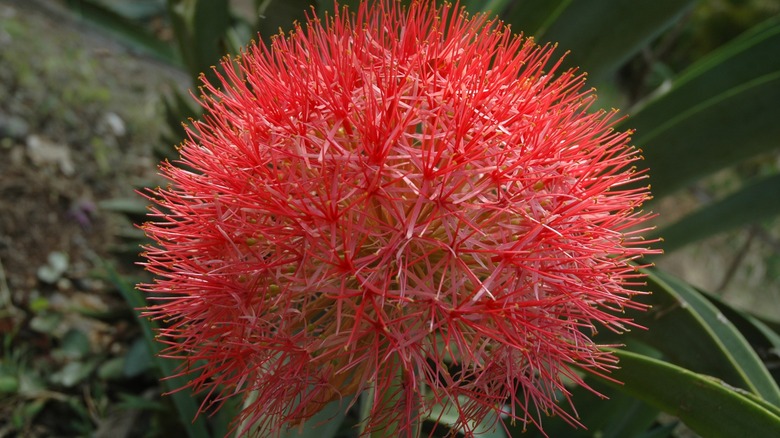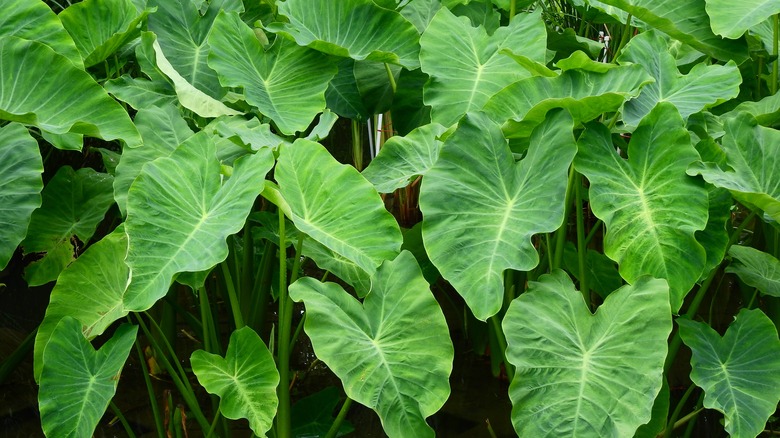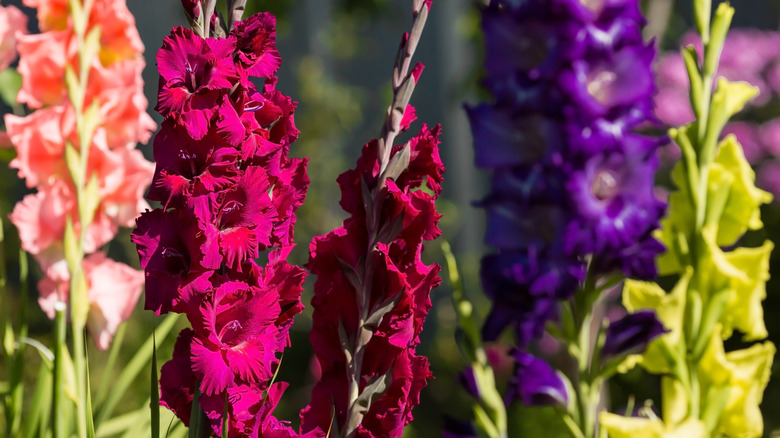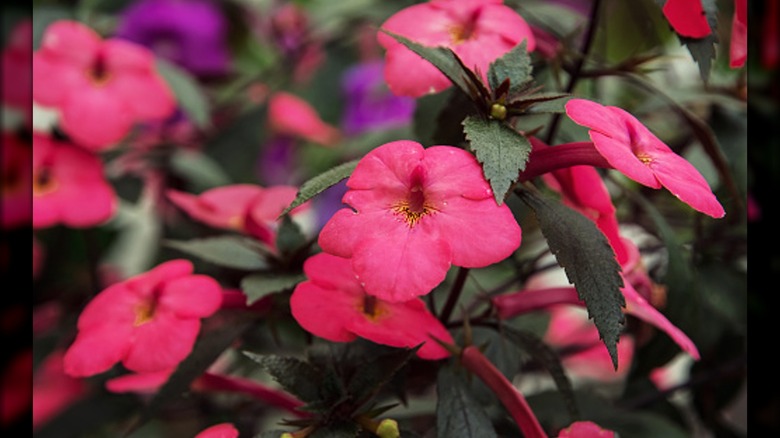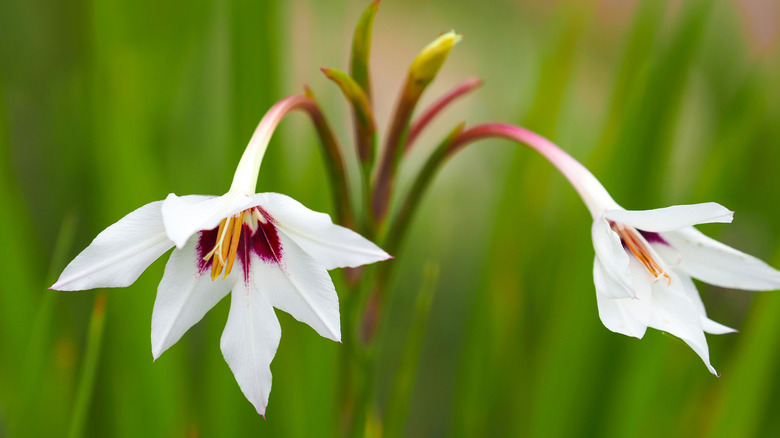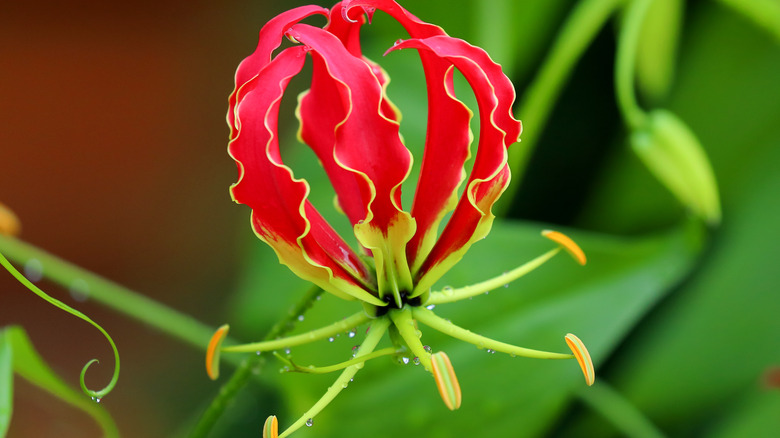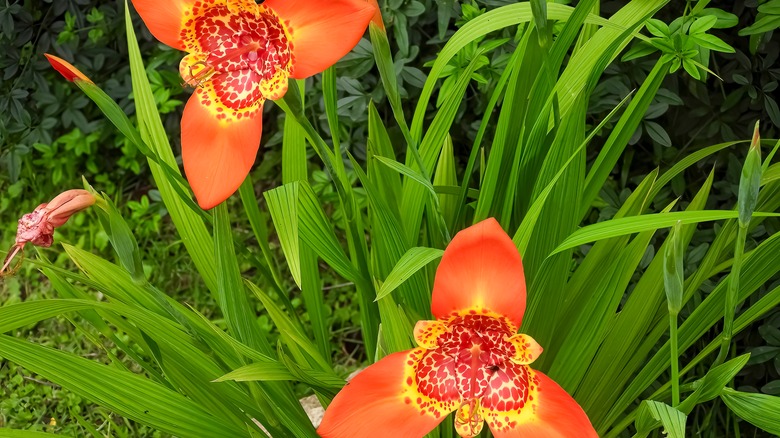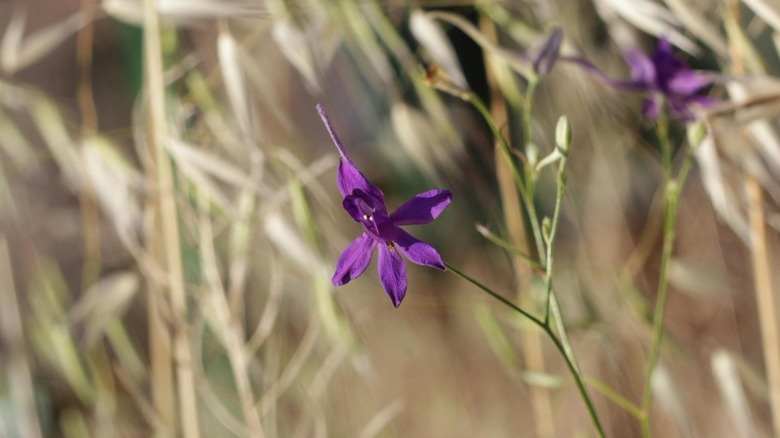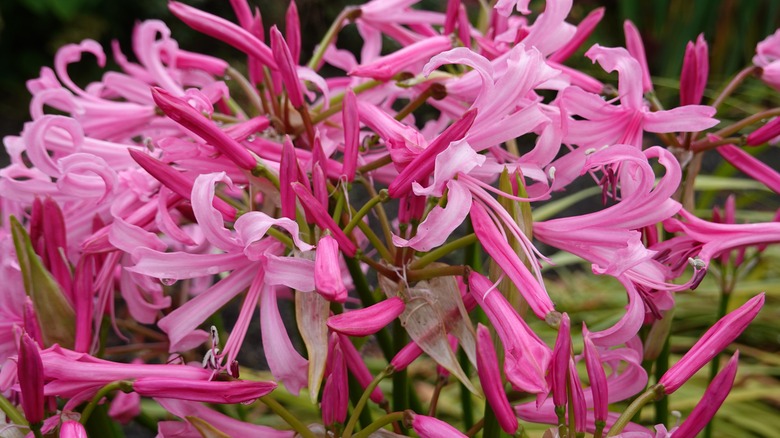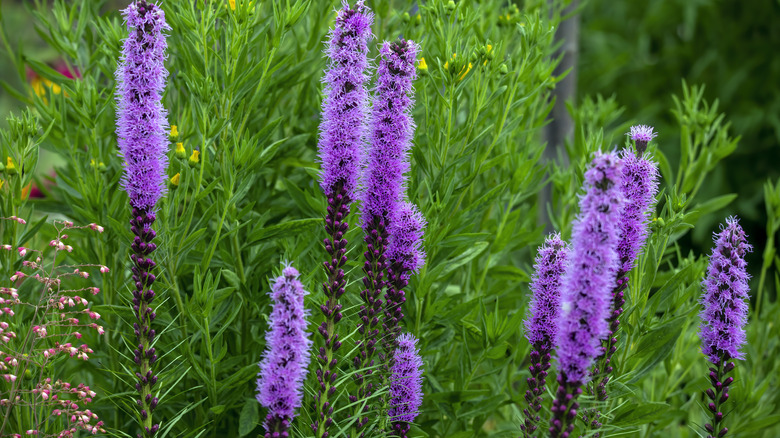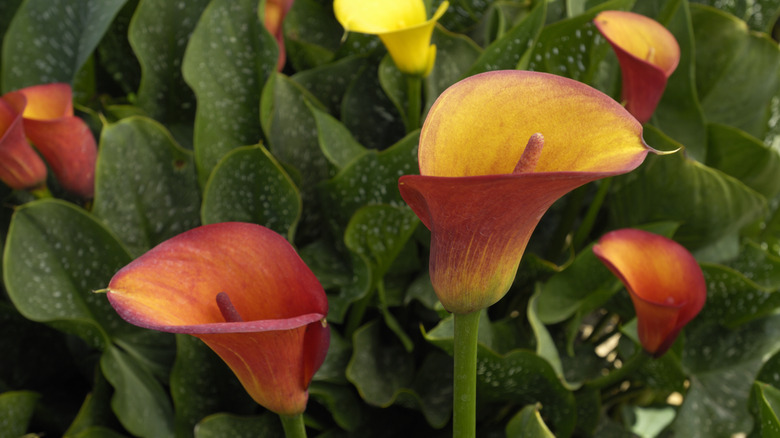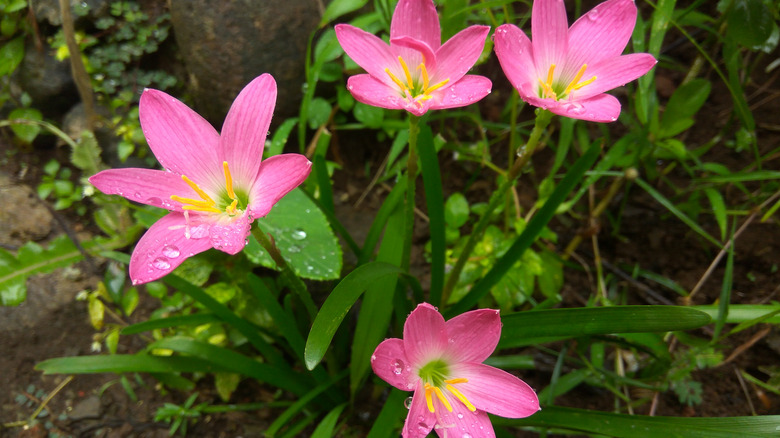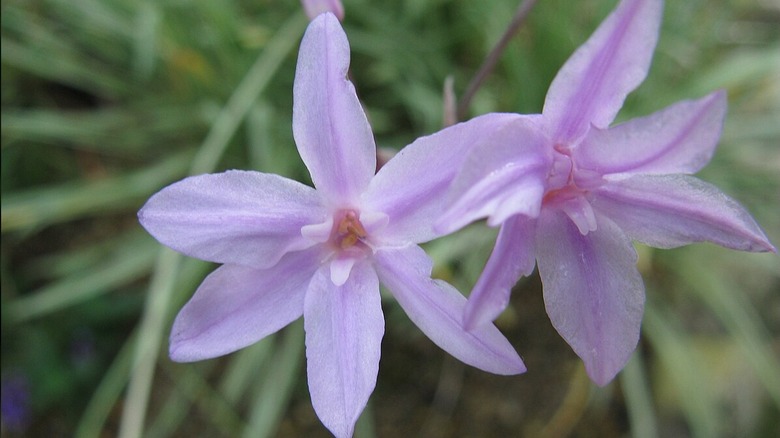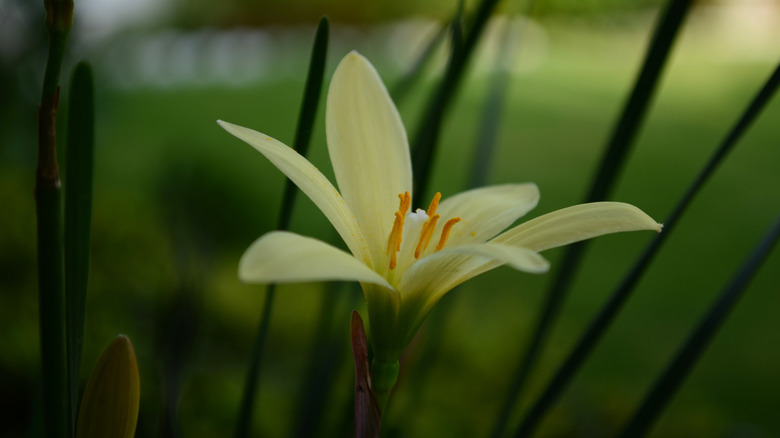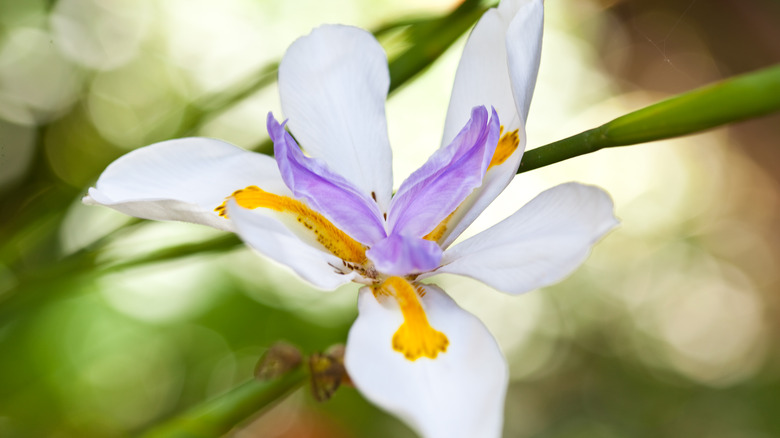28 Popular Summer Bulbs You Can Add To Your Garden (And What To Plant Them With)
Spring may be behind us, but that doesn't mean the floral spectacle must stop. If anything, it's time to heat things up this summer by growing more plants (everything's an occasion, isn't it?). While you might already be playing favorites by planting geraniums, roses, sunflowers, bougainvillea, and the like, flanking your perennial garden with summer bulbs might be an idea worth consideration. Just visualize the complementary play on colors, fragrances, and texture possible with lilies, gladiolus, tuberous begonias, Mexican shellflowers, cannas, caladiums, and more.
But before getting down and dirty, here are some tips. For starters, the bulbs (including corms, tubers, fleshy roots, or rhizomes, as they're classified botanically) shouldn't be soft and mushy. That's because such bulbs are usually indicative of not having been overwintered properly, raising the likelihood of poor blooms if they blossom at all. Instead, look for firm bulbs with their roots fully intact and healthy. Pay attention to the size and colors while designing your summer garden. Small bulbs create a soft and natural look, whereas taller contemporaries work better as specimens, accents, or overstories.
1. Tuberous begonia (Begonia x tuberhybrida)
Infuse beauty in a spot with dappled shade or underneath tall trees all summer long with over 2-inch wide, showy, double-accented flowers of tuberous begonias that come in pink, yellow, or red. However, be prepared to dig out the tubers before the first frost unless you're game for starting over next spring. Or, even better, plant their trailing varieties (think 'Double Delight Primrose' and 'Blush Rose') in garden pots, so that the over 12-inch long plants can be overwintered — unless you're in zones 9 to 11. Complement begonias' foliage with ferns, coleus, impatiens, or coral bells.
2. Summer hyacinth (Ornithogalum candicans)
Summer hyacinth's reclassification from the Galtonia to the Ornithogalum genus doesn't take away their ability to end summer in style. These sweet-smelling, bulbous plants grow bell-shaped, green-throated, wooly white flowers that love nodding to the ground while sitting atop basal green, sword-like foliage. The 2- to 4-foot-long plants grow best in moist, well-draining soils in zones 6 to 10 in full sun, but a little shade does no harm, especially in the afternoon. Couple them with echinacea, verbena, or African lilies in mixed beds or borders, and watch for slimy snails and slugs.
3. Asiatic lily (Lilium)
Birthed by crossing over 12 lily varieties, Asiatic lilies are perfect for kickstarting the summer blooming season early, lasting a month through the mid-season. While these under 5-foot tall plants aren't aromatic like their oriental cousins, they make up for it with their gorgeous, chocolate-speckled, double flowers blooming in vivid reds, yellows, whites, and similarly-shaded variegations. In sunny to part-shaded, loamy gardens of zones 4 to 8, their blooms attract bees and butterflies and can be accented with phlox, daylilies, peonies, lamb's ears, white sage, and roses. Watch out for stains while cutting, and keep cats away.
4. Ornamental onions (Alliums)
Although the odorous onion smell emanating from their rosulate foliage can repel some (including deer!), it hasn't stopped alliums from gaining a gateway into border and edible gardens. Varieties like 'Globemaster,' the giant onion, and the drumstick onion are popular in early summer, with the Turkistan onion and 'Serendipity' wooing their onlookers in late summer with their golf-sized umbels in a range of colors. Line them up with sedum, salvia, or peonies that mask their dying foliage. Alliums are best grown in sandy loam soils in sunny (or partly shaded) beds in zones 4 to 9.
5. Baboon flower (Freesia)
Another summer favorite, freesias are celebrated for their tubular flowers that line their tall racemes in a rainbow of colors. They smell gorgeous, too, which is why they're a hot favorite in cut arrangements and candles. However, they're a tad finicky since they withstand zone 9 and 10's winters until temperatures drop to 25 degrees Fahrenheit. So, it's best to grow freesias in container gardens where they can be mixed with larkspur, scabiosa, and gladiolus, or bunch them together haphazardly in the bed. They grow over 1 foot in full to part sun.
6. Caladium (Caladium bicolor)
Add textural contrast to your irises, fuchsias, Lenten roses, hostas, or impatiens with the heart-shaped or lance-shaped polychrome foliage of caladiums. Plant jumbo-sized bulbs (about 2 ½ and 3 ½ inches wide) in organically rich, warm soils — time it when you're growing tasty okra in the garden — especially if you've got a short summer season. Although the bulbs can be stored for next season, barring their white-leaved selections, including 'Moonlight' and 'White Christmas,' they are unlikely to fare well. Caladiums grow upwards of 12 inches in moderately shaded gardens of zones 9 to 10.
7. Tuberose (Polianthes tuberosa)
With a long cultivation history but without any association to the wild — which is why it's considered a cultigen — tuberoses are another intensely aromatic, spring-planted bulb. They produce waxy, stark white flowers that grow atop 3-foot-tall stems when summer is readying to give way to fall. Zones 7 to 10 are ideal ranges, provided that the soils are nutrient-rich and well-draining. They span over 2 feet on sunny sites and are best enjoyed around patios, sidewalks, or borders. Couple with dahlias and crocosmias, but remain alert for aphids.
8. Canna lily (Canna x generalis)
Although canna lilies produce glorious, three-petaled, carotenoid flowers from mid-summer until fall, they become a garden's showstopper because of their elliptical leaves that fall across the green-to-purple spectrum with glaucous coating to boot. Maturing between 1 and 8 feet (depending on the cultivar), they can be coupled with zinnias, dahlias, hibiscus, and ornamental grasses as overstories or intermixed in raised beds. Cannas host caterpillars and larvae while their red cultivars attract hummingbirds to your garden. Although hardy to zone 6, they must be overwintered in colder climates. They require full to part sun exposure.
9. Ismene (Hymenocallis)
A southern U.S. native plant, ismene (also called Peruvian daffodils or spider lilies) sprout fleshy, bluish-green foliage from their onion-shaped bulbs in zones 2 to 11, although those above 7 must winterize the bulbs inside. In the summer, the plant is adorned with ivory-white or tan-yellow, heavenly-scented umbels that hummingbirds, moths, and butterflies find enticing. They are a great fit for small, boggy gardens, given their somewhat short stature (30 inches) and love for moisture. But combine them with sun-loving, long-blooming perennials, as their display season is short. Cannas and elephant ears are a few worthy companions.
10. Montbretia (Crocosmia spp.)
Related to irises, crocosmias (or montbretia) are known for their fiery golden-red, tubular flowers that bloom from mid-summer to the first frost, enticing bees and hummingbirds to your garden. Even after blooms die back, songbirds visit for seeds while the waxy green foliage provides fall interest. Mass plant dozens of types of crocosmia with dwarf dahlias or mix with African lilies, yarrow, and verbena. It's adaptive to zones 5 to 9 in full sun, although part shade is necessary down south while those in upper regions may have to overwinter plants indoors. It may require staking.
11. Lily of the Nile (Agapanthus spp.)
Gardeners in zones 8 to 11 can prevent deer from munching on their flowers during the summer by planting drifts of lily of the Nile in the borders. Zone 7 dwellers may have a chance too, provided they mulch the winterizing clumps. With standout six-petaled, blue or lavender (rarely white) flower umbels, the 4-foot tall and half-as-wide plant magnetizes pollinators and hummingbirds. If left undivided, it can take over the flower bed, so space the tufts adequately when planting with the full sun to part-sun loving companions like crocosmia, roses, hydrangea, and ornamental grasses.
12. Bearded iris (Iris x germanica)
Lend your perennial garden a Mediterranean feel with bearded irises that bloom fragranced, six-petaled flowers in variegated shades, including blacks, blues, and burgundy, through the summer. Some cultivars like 'Immortality' and 'Again, and Again' put out a second flush. Full sun gives the showy blooms a better chance to resist diseases (especially mosaic viruses), but they also tolerate filtered light in zones 3 to 10. Pair the bearded iris with the garden favorite flower peony or other late-bloomers like Russian sage and other salvia plants. Handle with gloves, though, as it may cause contact dermatitis.
13. Dahlia (formerly Dahlia x hortensis)
Blooming flowers in various shapes and sizes in your choicest shades from the color wheel, barring true blues, dahlias are a bee and hummingbird-friendly summer bulb that deserve a place in all gardens. They require full sun and moist, fertile soils to showcase flowers till fall, but may lose their sheen when it gets especially hot without supplemental irrigation. Big-flowered dahlias may droop without staking support, while some cultivars may top out 6 feet in zones 7 to 10. Mix them with cosmos, verbena, calendula, and Amaranthus in flower beds or next to hedges.
14. Blood lily (Scadoxus multiflorus)
With an almost 10-inch-wide umbel, a densely-packed passel of burgundy-red, yellow-tipped florets, blood lilies make a perfect understory flowering perennial for trees so long as it receives morning sun during the summer. The red berries and rosette of strappy, green leaves that follow the blossoms, add to its fall appeal. Given its roots' penchant for girdling, it's best grown in pots but can be grown in moist, well-draining, rich soils of zones 9 to 11. Complement it with other summer bulbs, including dahlias and canna lilies. It grows 2 feet tall and is toxic to ingest.
15. Taro (Colocasia esculenta)
A foliage-forward option, taro or elephant ear supports colossal, nearly 3-foot-long, noticeably veined, ornate leaves. Depending on the cultivar, its foliage assumes varying shades of velvety black ("Black Coral"), royal maroon ("Blue Hawaii"), or variegated green ("Mojita" and "Hilo Bay"). Although it repels rabbits and deer, the plant is poisonous to humans and pets alike if consumed raw. It matures between 3 and 6 feet (and just as wide) in filtered to sunny spots of zones 8 to 11 but is considered invasive in the southeastern region. Keep it containerized or team it with dahlias and sage.
16. Sword lily (Gladiolus)
Most gardeners in zones 7 to 10 are glad when they plant gladiolus (abbreviated to glads), as they're easy to care for, attract bees, and put on a performance when other flowering plants are looking tired. Their slender, grooved foliage is bejeweled by perfumed, six-petaled, canular flowers in a rainbow of shades (based on the variety) from late summer to the frost hit. Site in full sun in moist, sandy loam soils to watch them gain almost 6 feet, but keep them from your pets. Plant them in bunches (over 7) next to peonies or dahlias.
17. Nut-orchid (Achimenes)
Another summer bulb for moderately shaded gardens, nut-orchid thrives in zones 10 to 11 but can be grown up to zone 7 if assured of the night temperatures staying above 50 degrees Fahrenheit during the growth season. Its flowers come in a variety of hues from bold blues to pastel pinks from summer through fall, with their funnel shape closely mimicking pansies. The fuzzy, almost chartreuse foliage contrasts well with ferns, Hosta, and coral bells in borders and beds. Site in moist, organically rich soils for the bulbs to grow roughly 2 feet tall.
18. Peacock orchids (Gladiolus murielae)
An heirloom variety, peacock orchids aren't orchids but irises that remain in the ground of zones 7 to 11 but can be grown as annuals in colder areas. The dainty, stilliform white blooms encase a deep purple eye and must be staked to keep them from nodding in windy sites. The summer bulbs stand almost 3 feet tall and produce fragrant (reminiscent of jasmines) blooms from summer through fall. Mass plant in groups of 10 bulbs with ornamental grasses like prairie dropseed and fountain grass for a textural play.
19. Flame lily (Gloriosa superba)
Boasting incendiary red-yellow, bell-shaped flowers with curled tips, the flame lily has piqued the interest of several avant-garde gardeners despite its poisonous properties, which takes effect if consumed in considerable amounts (Gloriosa has a history of medicinal use). As it shoots out tendrilled green leaves from its tuber, it's best to use a trellis to support your plants. Happy to grow over 6 feet tall in rich, sandy soils of zones 8 to 12, the summer bulb can turn aggressive, transforming into a noxious weed in some U.S. regions, advancing the case of keeping them potted.
20. Mexican shellflowers (Tigridia Pavonia)
Up your gardening game with 2-foot-tall Mexican shellflower summer bulbs. While each flower blooms only for a day, it is downright gorgeous, supporting three, triangularly placed, solid-hued petals encircled around a contrasting triplet of mottled petals (imagine yellow, white, or pink against sultry red). Thankfully, when planted right, meaning in rich, well-draining soils in zone 8 to 10 in full sun, the bulbs produce successive blossoms, inviting in pollinators. In cold regions (2 to 7), they can be overwintered indoors. Plant in drifts of 6 bulbs for an enchanting display or intersperse with agapanthus and echinacea.
21. Painted petals (Lapeirousia)
Also known as pink bermudiana, painted petal plants are early summer bloomers that grow in all kinds of dimensions and colors — although, generally, most cultivars feature small, fragrant, six-petaled, red-to-pink blooms with darker-toned, splotchy eyes. While winter hardy in zones 8 to 10, they can be planted up to zone 3 as annuals and later moved indoors for the winter. Grow them on sunny sites with slightly acidic soils, although they withstand some shade as well. The bulbs remain under 1 foot and are best massed in borders or left potted.
22. Guernsey lily (Nerine)
Nerines should be on the go-to list for those seeking late-season interest in their partially shaded gardens during the summer. These bulbs grow impressive, lustrous, funnel-shaped, wavy-petaled pink or white flowers in dense clusters that die down in fall to allow the perennial to grow fleshy, strapped leaves along the length of its stems. Hardy to zones 8 to 10, nerines can grow over 1 foot tall in well-draining soils, and can be matched with African lilies, sedum, and hydrangeas. However, to enjoy the best flush, grow them in containers.
23. Blazing stars (Liatris spp.)
Indigenous to North America, blazing stars or gayfeather feel most at home in butterfly or pollinator gardens. Their spiky, bottle-brush inflorescence gets decked with under 1-inch wide, flashy violet or rosy flowers that open from top to down, in sharp contrast to the bottom-to-top pattern found in similar wildflower plants. Use them as accents for lamb's ear, artemisia, purple coneflowers, and cosmos for summer interest. They are adaptive to zone 3 where they can grow almost 5 feet tall if their cultivar's characteristics allow for it. Grow in partial shade to full sun.
24. Calla lily (Zantedeschia spp.)
Cold hardy in zones 7 to 10, calla lilies are some of the prettiest summer bulbs to plant in spring, if their sculpturally elegant, funnel-shaped spathes (flowers) gracing mottled green foliage are any indication. However, Californians may want to give their white cultivar Zantedeschia aethiopica, the ubiquitous, bridal-bouquet favorite, a skip, since it is considered invasive in their area. Grow these lilies in rich, wet soils and dappled to full sun with companions like astilbes, impatiens, and ferns for summerlong interest. But pet parents should avoid it altogether, as the plant is fatally poisonous.
25. Pink rain lily (Zephyranthes grandiflora)
If the name's any hint, rain lilies star attractive, star-like pastel pink, yellow-throated flowers once they've been rained on, although the show persists throughout the summer with multiple flushes. As they trace their parentage to the West Indies, these bulbs are known to stand salt, making them ideal along coastal sites. Clump them together in sunny spots in zones 7 to 10 or pair them with blue fescue or echeveria for a color contrast. Plants grow up to 1 foot tall and twice as wide in well-draining soils.
26. Society garlic (Tulbaghia violacea)
Not to be mistaken for garlic chives, society garlic is an Amaryllis member that sprouts 2 foot-long stems all summer through early fall, terminating in clusters of tiny, star-shaped, vibrant rosy-lilac flowers. Hardy in zones 7 to 10, it's resistant to salt, drought, and deer, and works well for xeric landscapes. To get the best blooms (and garnishes!), plant in full sun; otherwise, part shade works. Since the bulb stays under 1 foot, it makes a good ground cover, although some might not appreciate the garlic smell. Otherwise, use it to complement Eucomis and blue fescue.
27. Evening rain lily (Zephyranthes drummondii)
Well-adapted to zones 7 to 10, evening rain lilies or prairie lilies are the star of a sensory or a night garden during the summer, and for good reason. After rain, they open their ephemeral, snow-white flowers around dusk, dying out as delicate pinks in a few days. They support glaucous, mow-tolerant foliage, which helps them naturalize in lawns and meadows, in line with their native heritage. Site in full sun to have butterflies and bees visit your garden, although moderate shade works too. Use the nearly 1-foot plant to front the borders.
28. Butterfly iris (Dietes iridioides)
Synonymously known as fortnightly irises for their proclivity to put out flower flushes every two weeks, dietes are a grand addition in zones 8 to 11 thanks to their gorgeous, yellow-violet mottled, pearl white, or blonde flowers. The inflorescence marks its presence from spring to fall (rarely in winter) while standing tall atop lance-like, near-evergreen clumps. Grow in full sun along with verbena, autumn sage, yucca, or rosemary. But if planting in a shaded spot, allow it to substitute in for turf. The bulbous plant grows 3 feet tall and 4 feet wide.
